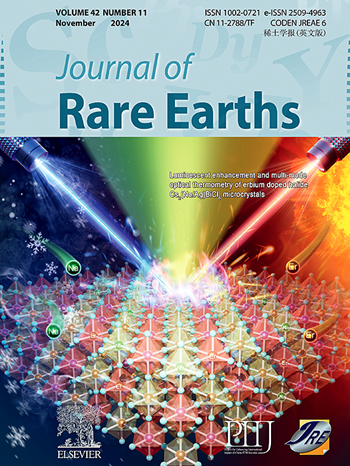稀土掺杂对Cu-Mg-Zn铁氧体结构、光学、介电和湿度性能的影响
IF 7.2
1区 化学
Q1 CHEMISTRY, APPLIED
引用次数: 0
摘要
采用化学共沉淀法合成了化学式为Cu0.3Zn0.3Mg0.4TxFe2-xO4 (x = 0,0.1; T = La, Ce, Sr)的稀土掺杂铁氧体。研究了稀土元素掺杂Cu-Mg-Zn铁氧体的结构、光学、电学和湿度传感性能。通过x射线衍射(XRD)证实了该晶体的单相立方尖晶石结构,根据Scherrer公式,晶粒尺寸在22.12 ~ 63.17 nm之间,根据Williamson-Hall方法,晶粒尺寸在25.66 ~ 67.46 nm之间。利用扫描电镜(SEM)研究了样品的孔隙结构和元素表征。光学带隙在2.21 ~ 2.49 eV之间变化。电测量的频率范围为1 Hz-20 MHz,温度范围为25-400°C。从奈奎斯特图中可以看出,介电结果与麦克斯韦-瓦格纳方法一致,并表现出非德拜松弛模型。在最小频率为1 Hz时,纯样品、Ce、Sr和La样品在25℃时的介电常数分别为9 × 104、5 × 104、1 × 108和2 × 105,在400℃时的介电常数分别为1.85 × 108、1.34 × 108、1.15 × 1010和4.4 × 108。在最高频率为20 MHz时,25℃时介电常数依次为169、166、3799和60,400℃时介电常数依次为734、624、12108和774。La掺杂样品的低介电损耗使其适合于高频应用。湿度测量在室温和5%-95%的相对湿度范围内进行。通过湿度测绘、灵敏度、迟滞和长期稳定性试验研究了样品的湿度特性。结果表明,与其他样品相比,Ce具有较好的湿度性能,灵敏度为99%,重复性最高(91.2%)。这些结果表明,掺铈铁氧体可以作为一种低成本、高性能的湿度传感器。本文章由计算机程序翻译,如有差异,请以英文原文为准。

Effect of rare earth doping on structural, optical, dielectric, and humidity properties of Cu–Mg–Zn ferrites
Rare earth (RE) doped ferrites with the chemical formula Cu0.3Zn0.3Mg0.4TxFe2–xO4 (x = 0, 0.1; T = La, Ce, Sr) were synthesized by chemical co-precipitation method. The structural, optical, electrical and humidity sensing properties of Cu–Mg–Zn ferrites with rare earth element doping were investigated. Single-phase cubic spinel structure was confirmed via X-ray diffraction (XRD), and the crystal size ranges from 22.12 to 63.17 nm according to the Scherrer formula and from 25.66 to 67.46 nm according to the Williamson–Hall method. Porous structure and elemental characterization of the samples were investigated by scanning electron microscopy (SEM). The optic band gap varies between 2.21 and 2.49 eV. Electrical measurements were conducted in the frequency range of 1 Hz–20 MHz and temperature range of 25–400 °C. It has been determined that the dielectric results are consistent with the Maxwell–Wagner method and exhibit a non-Debye relaxation model, as observed from the Nyquist plots. At a minimum frequency value of 1 Hz, the dielectric constants for pure, Ce, Sr, and La samples are 9 × 104, 5 × 104, 1 × 108, and 2 × 105 at 25 °C, and 1.85 × 108, 1.34 × 108, 1.15 × 1010, and 4.4 × 108 at 400 °C. In the same order, for the maximum frequency value of 20 MHz, the dielectric constants at 25 °C are 169, 166, 3799, and 60, while at 400 °C they are 734, 624, 12108, and 774. The La doped sample's low dielectric loss makes it suitable for high-frequency applications. Humidity measurements were performed at room temperature and in the 5%–95% relative humidity range. The humidity properties of the samples were investigated through humidity mapping, sensitivity, hysteresis, and long-term stability tests. Compared to other samples, the results indicate that Ce exhibits better humidity performance with 99% sensitivity and the highest repeatability (91.2%). These results show that Ce-doped ferrite can be used as a low-cost, high-performance humidity sensor.
求助全文
通过发布文献求助,成功后即可免费获取论文全文。
去求助
来源期刊

Journal of Rare Earths
化学-应用化学
CiteScore
8.70
自引率
14.30%
发文量
374
审稿时长
1.7 months
期刊介绍:
The Journal of Rare Earths reports studies on the 17 rare earth elements. It is a unique English-language learned journal that publishes works on various aspects of basic theory and applied science in the field of rare earths (RE). The journal accepts original high-quality original research papers and review articles with inventive content, and complete experimental data. It represents high academic standards and new progress in the RE field. Due to the advantage of abundant RE resources of China, the research on RE develops very actively, and papers on the latest progress in this field emerge every year. It is not only an important resource in which technicians publish and obtain their latest research results on RE, but also an important way of reflecting the updated progress in RE research field.
The Journal of Rare Earths covers all research and application of RE rare earths including spectroscopy, luminescence and phosphors, rare earth catalysis, magnetism and magnetic materials, advanced rare earth materials, RE chemistry & hydrometallurgy, RE metallography & pyrometallurgy, RE new materials, RE solid state physics & solid state chemistry, rare earth applications, RE analysis & test, RE geology & ore dressing, etc.
 求助内容:
求助内容: 应助结果提醒方式:
应助结果提醒方式:


